The integrity of the plum trees, which bloom in early spring with a fragrant fragrance, along with evergreen pines and snow-resistant bamboo, is called “Saikan no Sanyu(歳寒三友)” and has long been favored by Japanese people who value good luck.
When a plum tree bears fruit, people think that it is like a mother with many children who always bears fruit on every branch, and people think of it as an “auspicious tree.”
Introducing a plum pattern with a pattern of such plum!
What is Plum(Ume/梅)?

Plum(Ume/梅) is a deciduous tree native to China belonging to the genus Apricots and the genus Prunus of the family Rosaceae, and there are various theories, but it seems to have come to Japan via the Korean Peninsula.
The exact time of arrival is not known yet, but judging from the poems written in “Manyoshu(万葉集)” (Collection of Ten Thousand Leaves), it seems that it was already cultivated during the Nara period.
By the way, “Manyoshu(万葉集)” is the country’s oldest anthology of poems with more than 4500 poems composed by people of various ranks from the Emperor and nobles to lower-ranking government officials and Sakimori (soldiers garrisoned at strategic posts in Kyushu).
The number of poems about Plum(Ume/梅) is second to Hagi, and there are as many as 118 poems. It can be said that flowers have been loved in Japan for a long time, so much so that they used to refer to “Plum(Ume/梅).”
Plum(Ume/梅) is roughly divided into “Hanaume(花梅)” and “miume(実梅),” but the line between these two categories is basically vague.
“Hanaume(花梅)” is a variety that has been improved for the purpose of viewing flowers. You can enjoy the color and fragrance of flowers, the way they bloom and the shape of trees.
“miume(実梅)” refers to a variety whose purpose is to enjoy harvesting fruit, and miume(実梅) also produces fragrant ornamental flowers.
Both of them seem to be able to enjoy beautiful flowers, but to put it simply, they are divided into ornamental and edible flowers.
It is a famous story that Sugawara no Michizane(菅原道真) loved Plum(Ume/梅). I’ll talk about this episode later.
However, not only Sugawara no Michizane(菅原道真), but also the Plum(Ume/梅) trees have been loved by our predecessors who have represented Japan.
There seems to be an anecdote about Plum(Ume/梅), Toyotomi Hideyoshi(豊臣秀吉) and Sen no Rikyu(千利休).
One spring, he ordered Sen no Rikyu(千利休) to “Put this Plum(Ume/梅) in this bowl.” by attaching only a branch of the red Plum(Ume/梅) tree to a large bowl filled with water placed in the alcove by Toyotomi Hideyoshi(豊臣秀吉). While his aides were watching him with suspense, saying, “This is a difficult task,” Sen no Rikyu(千利休)a calmly took the branches of red Plum(Ume/梅), and as soon as he did so, he put only the flowers and buds of red Plum(Ume/梅) into the bowl. It is said that Toyotomi Hideyoshi(豊臣秀吉) became happy with the taste of red Plum(Ume/梅) blossoms floating on the water.
In addition, there seems to be an anecdote about Plum(Ume/梅) and Tokugawa Ieyasu(徳川家康).
There was a beautiful plum tree in Sunpu Castle(駿府城) where Tokugawa Ieyasu(徳川家康) spent his later years. It was a very rare tree whose seeds split in two when ripe, and it was called Minewari-ume(実割梅). At that time, Sunpu Castle(駿府城) had a tradition of pickling umeboshi (pickled plums) from this fruit Minewari-ume(実割梅) and placing them in Tosho Shrine(東照宮). The tree is said to have been planted by Tokugawa Ieyasu(徳川家康) himself, and the tree was later transplanted from Sunpu Castle(駿府城) to the Tosho Shrine(東照宮) grounds of the Tang Dynasty(唐門下).
It is not an exaggeration to say that Plum(Ume/梅), which is loved by famous nobles and military commanders, is one of the flowers that represent the heart of Japan.
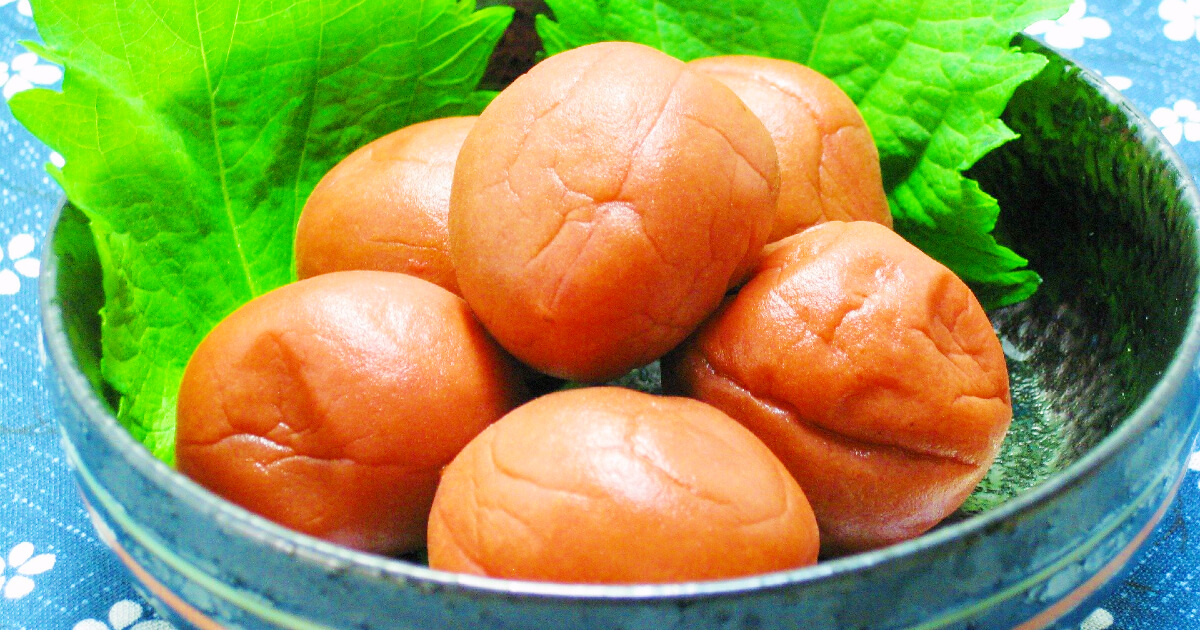 About ‘Umeboshi’ (pickled plum) which was mentioned in the anecdote of Plum(Ume/梅) and Tokugawa Ieyasu(徳川家康) earlier.
About ‘Umeboshi’ (pickled plum) which was mentioned in the anecdote of Plum(Ume/梅) and Tokugawa Ieyasu(徳川家康) earlier.
Umeboshi (pickled plums) are pickled plum fruits in salt, dried, and pickled in plum vinegar with perilla leaves.
The color is reddish colored from perilla leaves, and there are various types from soft large grains to crunchy small grains.
The taste is salty and sour, and depending on the type, there are also umeboshi (pickled plums) that contain honey and are easy to eat for everyone, and they often appear on Japanese tables as an accompaniment to rice.
Umeboshi (pickled plums) from Kishu (Wakayama Prefecture) are especially famous nationwide.
Umeboshi (pickled plums) appear in “Part Food and Nutrition(食養編)” of “Ishinpo(医心方),” the oldest medical book in Japan, written by a doctor, Tanba no Yasuyori(丹波康頼), in the Heian period.
It is described as “The taste is acid, flat and non-toxic. It is used to calm down, remove fevers and scruples, soothe the heart, heal pain in limbs and paralysis of limbs, and heal skin damage and atrophy. Stop diarrhea and dry mouth” which shows that Umeboshi (pickled plums) was used medicinally among Japanese in the past.
Plum(Ume/梅) is also described in “Wakan Sansai Zue(和漢三才図会)” (Japanese and Chinese Sansai Zue), a pictorial encyclopedia from the Edo period.
At the end of the Edo period, as the number of visitors from other countries increased, an epidemic broke out, and around 1800, cholera spread 2 times throughout the country. It seems that Umeboshi (pickled plums) was very popular at that time.
It was not known that Vibrio cholerae was sensitive to organic acids, but people at that time knew from experience that Umeboshi (pickled plums) had strong bactericidal properties, and they used them to treat it.
Later, it seems that Umeboshi (pickled plums) played an active role during a cholera epidemic in 1875.
Umeboshi (pickled plums) have played an important role in this kind of medical treatment, and even today, their efficacy is attracting so much attention that they are used in a medical book called “Akabon(赤本).” Akabon(赤本) is a family medicine book that has been in print since its first publication in 1925.
It’s a big bestseller with a total circulation of over 10 million.
The effect of plum pulp extract is written on the red book. While many health methods have appeared, become popular, and have been forgotten, it is still read and used to this day.
Umeboshi (pickled plums) is not only used in medicine, but also in the Muromachi period(1336-1568), it was used by samurai as an appetite stimulant.
Even in the Sengoku Period (Period of Warring States), umeboshi was still a medicine, not a food.
Plum(Ume/梅) seems to have been one of the field rations eaten during the battles of the samurai and the Sengoku period (period of warring states/1467-1615).
It was very convenient because it was easy to take nutrition quickly and carry, it was easy to store, and it was easy to get and make.
This is said to be the reason why plum trees spread all over the country. There are many famous places.
Umeboshi (pickled plum) seems to be a medical and health food for Japanese.
Just be careful not to take too much! You might take too much salt.
About Plum Pattern(梅文/Ume Mon)
Plum(Ume/梅) blossoms quickly in the severe cold and bears many fruits.
Plum Pattern(梅文/Ume Mon) is a symbol of perseverance, vitality, and the prosperity of descendants, and is a typical auspicious omen pattern for the new year.
There are many kinds of Plum Pattern(梅文/Ume Mon), such as Yari-ume(槍梅) with flowers on straight branches, Nejiri-ume(ねじり梅) with twisted petals, and’ Ume-bachi(梅鉢) ‘ with a design in which plum flowers are seen from the front.
 Family crest: yae-mukou-ume
Family crest: yae-mukou-ume
家紋:八重向こう梅(やえむこううめ)
photo:フリー素材サイト発光大王堂
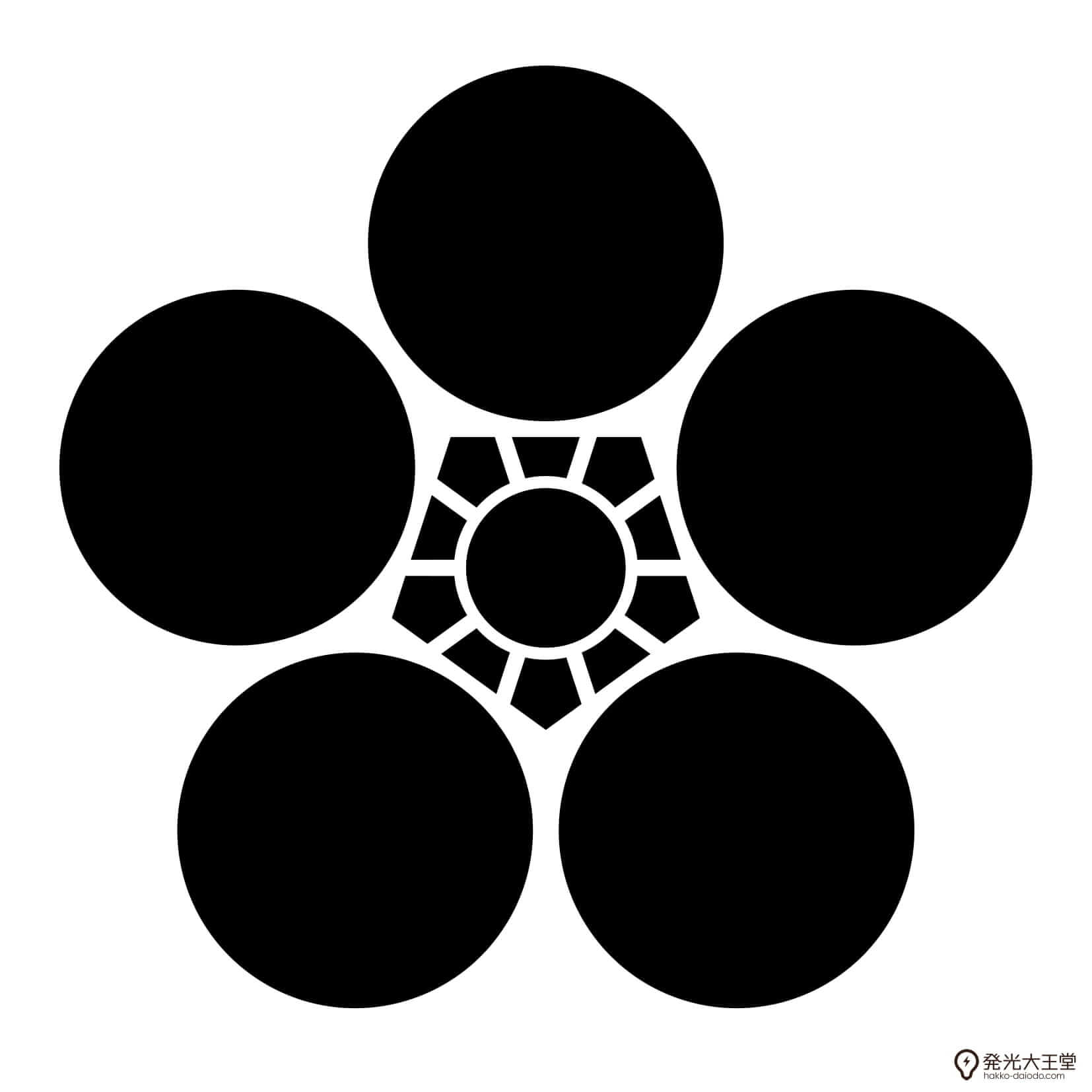
Family crest: ume-bachi
家紋:梅鉢(うめばち)
photo:フリー素材サイト発光大王堂
Umeka-mon includes Muko-ume(向こう梅) and Yokomi-ume(横見梅) with a center, and Omote-ume(表梅), Ura-ume(裏梅), and Korin-bai(光琳梅) without a center.
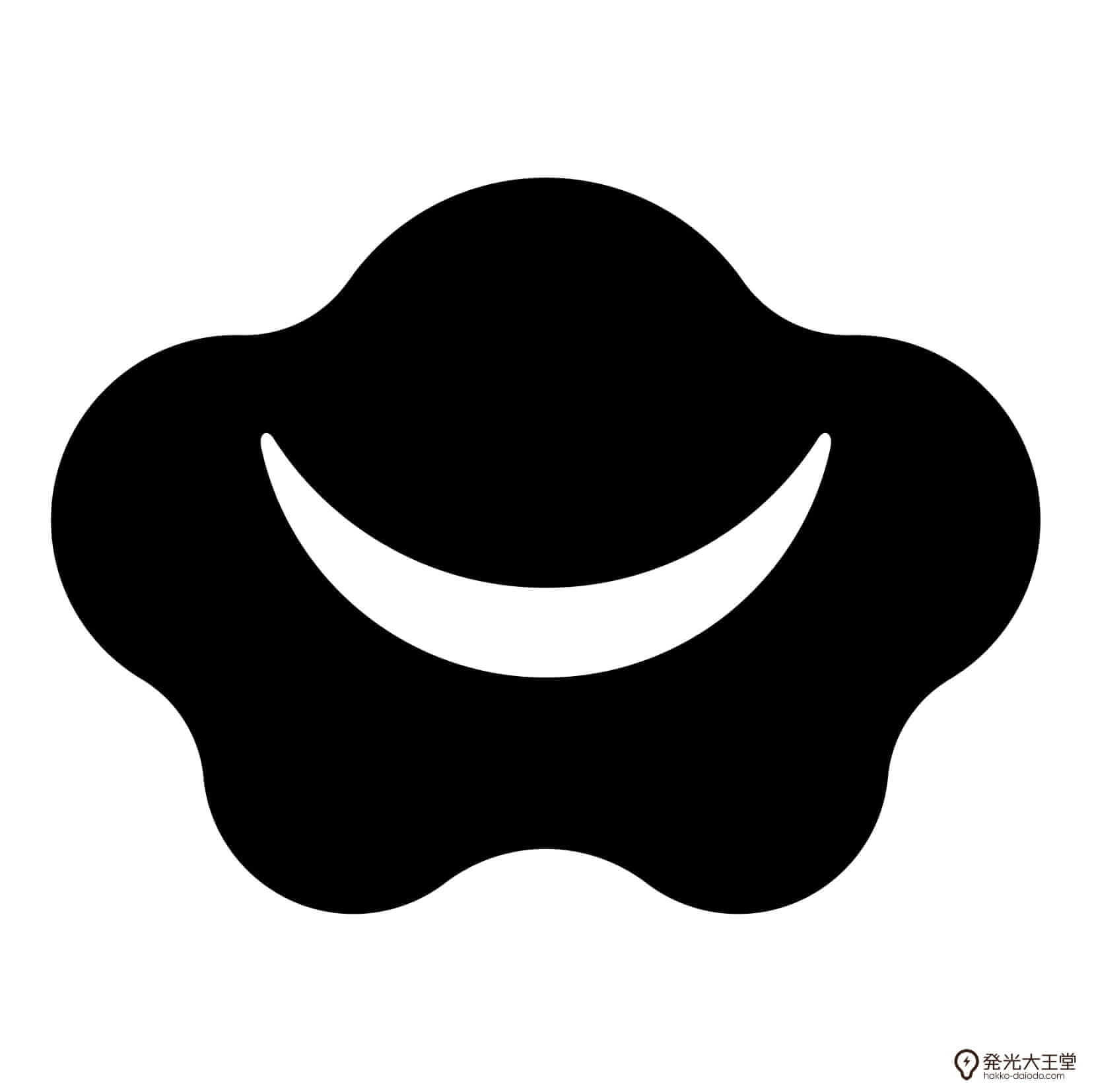
Family crest: kourin-bai
家紋:光琳梅(こうりんばい)
参考:フリー素材サイト発光大王堂
Other than that, there are various Umemon such as “Yae(八重)” and “Twist(Neji/捻じ)”.

Family crest: kasane-ume
家紋:重ね梅(かさねうめ)
参考:フリー素材サイト発光大王堂
Ume-bachi(梅鉢文) patterns include “Kenume-bachi(剣梅鉢)” with a stem, “Hoshiume-bachi(星梅鉢)” without a stem, and “Uraume-bachi(裏梅鉢)”.
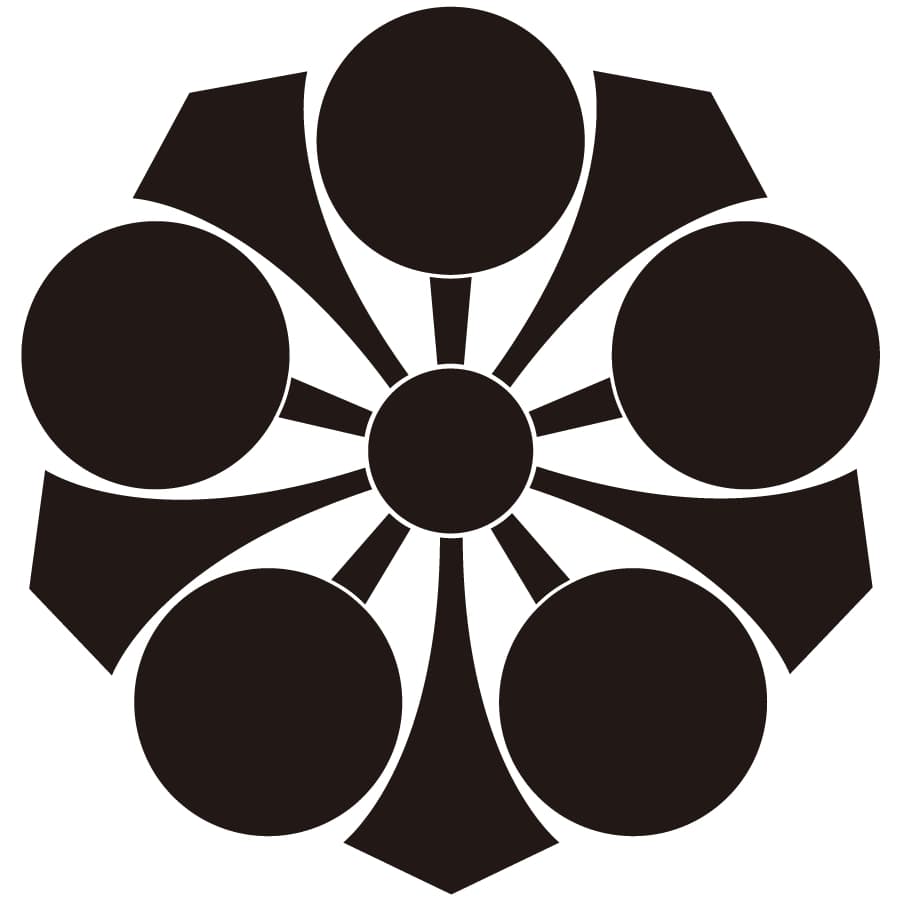
Family crest: kenume-bachi
家紋:剣梅鉢(けんうめばち)
参考:家紋のいろは

Family crest: ura-ume
家紋:裏梅(うらうめ)
参考:家紋のいろは
There are as many designs as loved.
This is not the only way to stop the love of plum trees.
Plum Pattern(梅文/Ume Mon) brings to mind the crest of Tenman shrine (天満宮/heavenly god of heaven).
Tenman shrine (天満宮/heavenly god of heaven) is one of approximately 12,000 shrines throughout Japan that enshrine Tenjin (Sugawara no Michizane/菅原道真).
Its Sohongu is Dazaifu Tenmangu Shrine, which is revered as “a god of learning, shisei and warding off evil.”
After his death, Sugawara no Michizane(菅原道真), who loved plum trees, was enshrined as Tenman shrine (天満宮/heavenly god of heaven) to calm natural disasters that occurred in the capital.
Since then, many plum trees have been planted in the precincts of Tenman shrine (天満宮/heavenly god of heaven), and the plum festival is held in early spring.
Sugawara no Michizane’s famous haiku(句/Ppem)
“東風吹かば 匂ひおこせよ梅の花 主なしとて 春を忘るな ”
Reading: Kochi fukaba nihoiokoze ume no hana aruji nashi to haruna wasiso
Translation: It’s my(Sugawara no Michizane/菅原道真) plum blossom. If the east wind blows, please deliver the smell to Dazaifu(大宰府) where I am(Sugawara no Michizane/菅原道真). Don’t forget spring just because I’m not here.
Before Sugawara no Michizane(菅原道真) was falsely accused and demoted to Dazaifu(大宰府), this waka was composed by Sugawara no Michizane(菅原道真) in order to talk to his beloved Plum(Ume/梅) tree.
How much did Sugawara no Michizane(菅原道真) love Plum(Ume/梅) blossoms? I think it is a clear waka.
I could definitely say that Plum(Ume/梅) is a beautiful flower tree that has been fascinated and loved by Japanese people since a long time ago.
Design using Plum Pattern(梅文/Ume Mon)
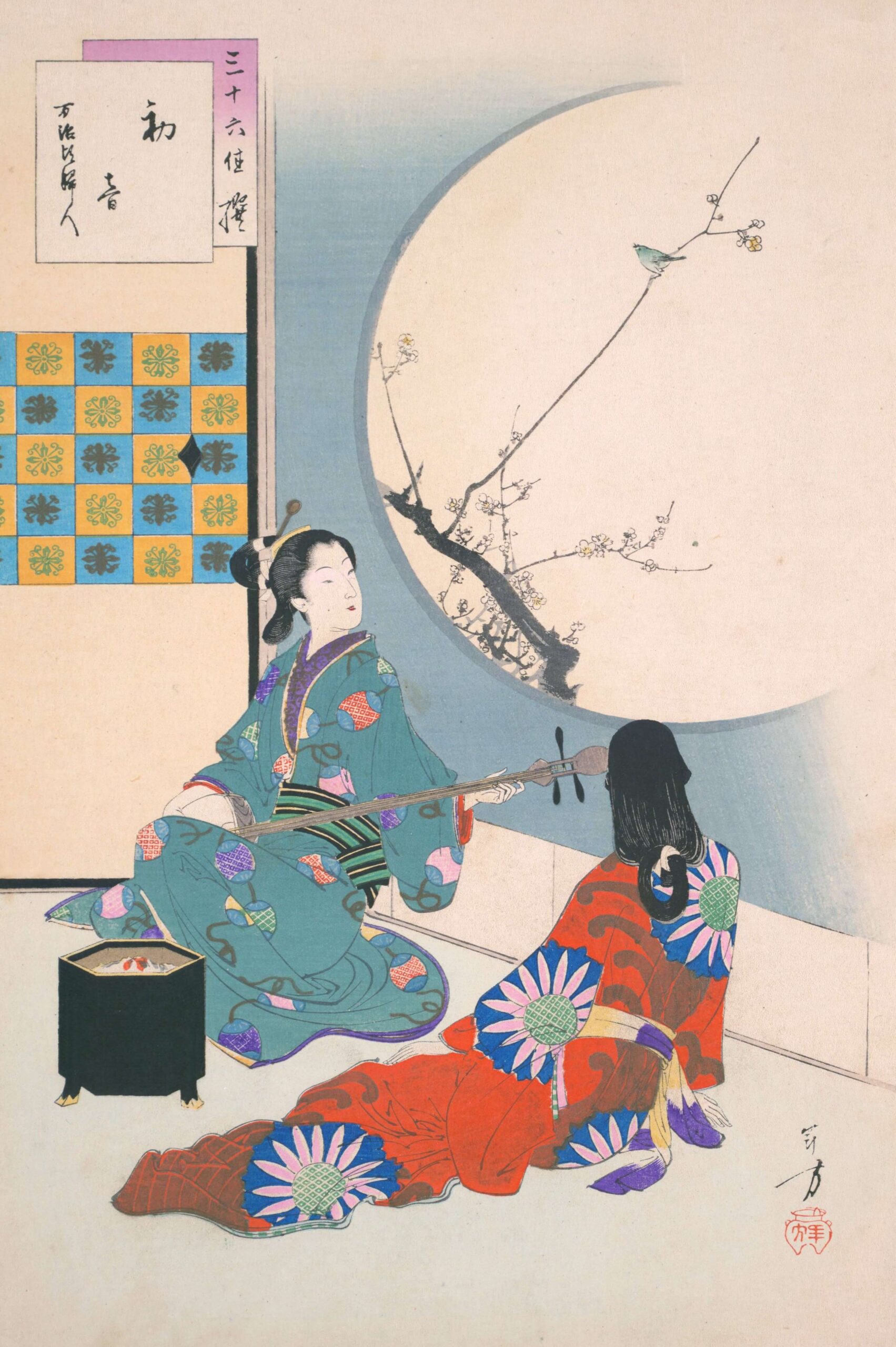 Toshikata MIZUNO ’36 Kasen Hatsune Manji goro Fujin’ (1893)
Toshikata MIZUNO ’36 Kasen Hatsune Manji goro Fujin’ (1893)
水野年方 「三十六佳撰 初音 万治頃婦人」 (1893)
photo:パブリックドメインQ:著作権フリー画像素材集
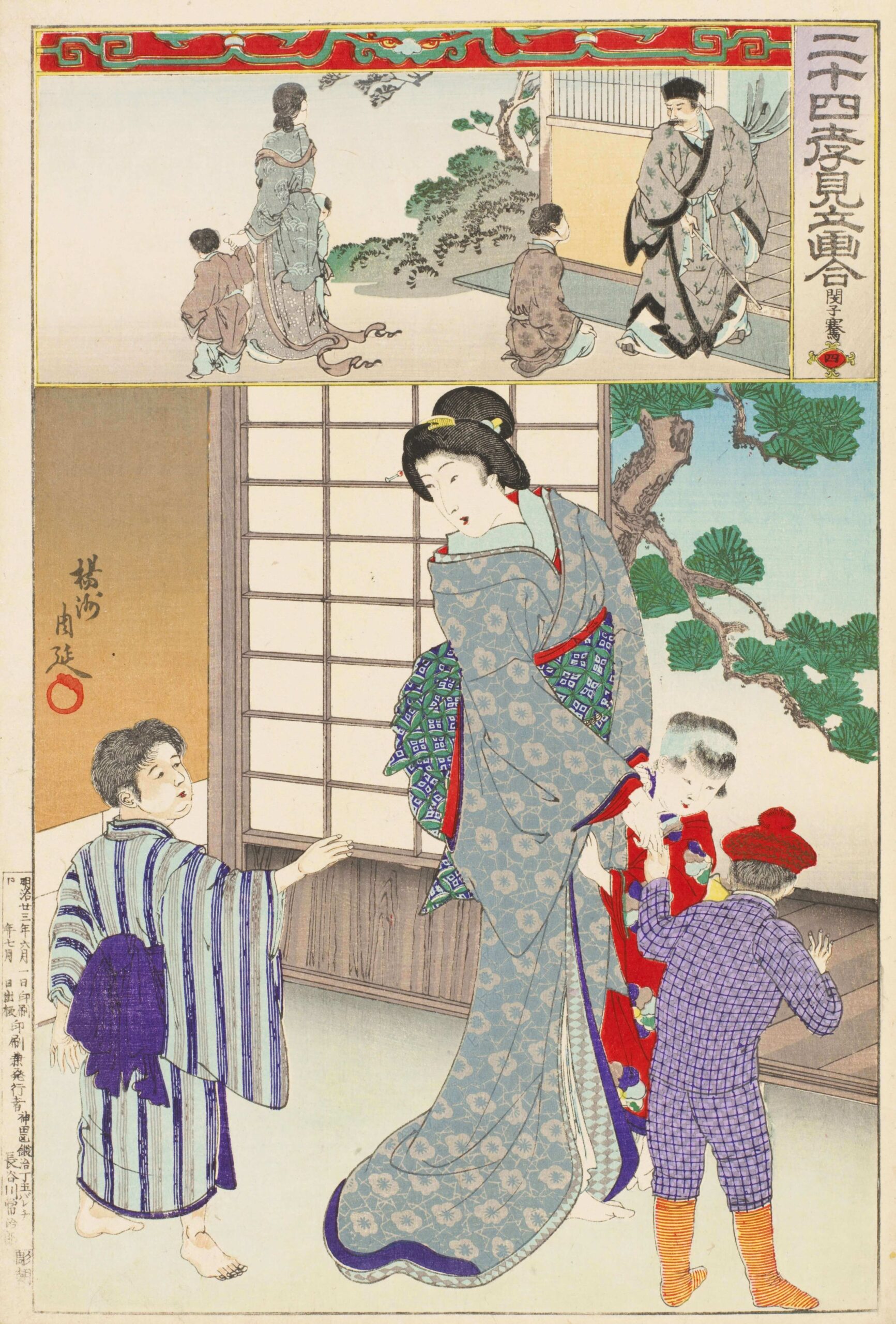 Shuen YANSHU, ‘Twenty-Four Koken Collection, No. 4 Bin-Shiken’ (1890)
Shuen YANSHU, ‘Twenty-Four Koken Collection, No. 4 Bin-Shiken’ (1890)
楊洲周延 「二十四孝見立画合 第四号 閔子騫」 (1890)
photo:パブリックドメインQ:著作権フリー画像素材集
この投稿をInstagramで見る

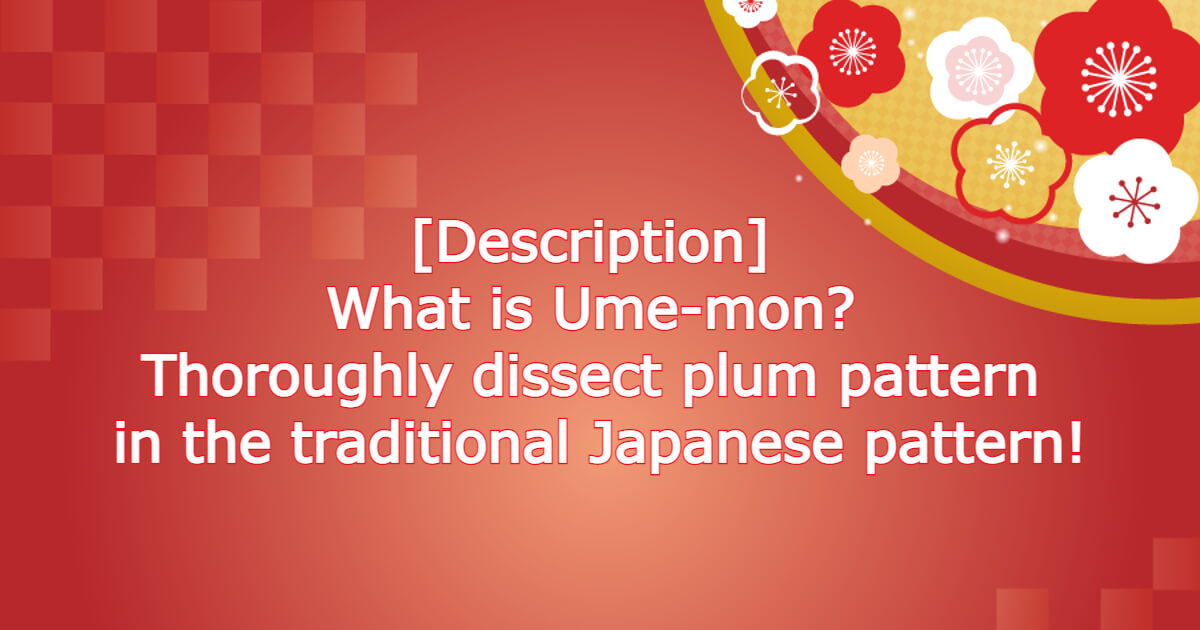



コメント